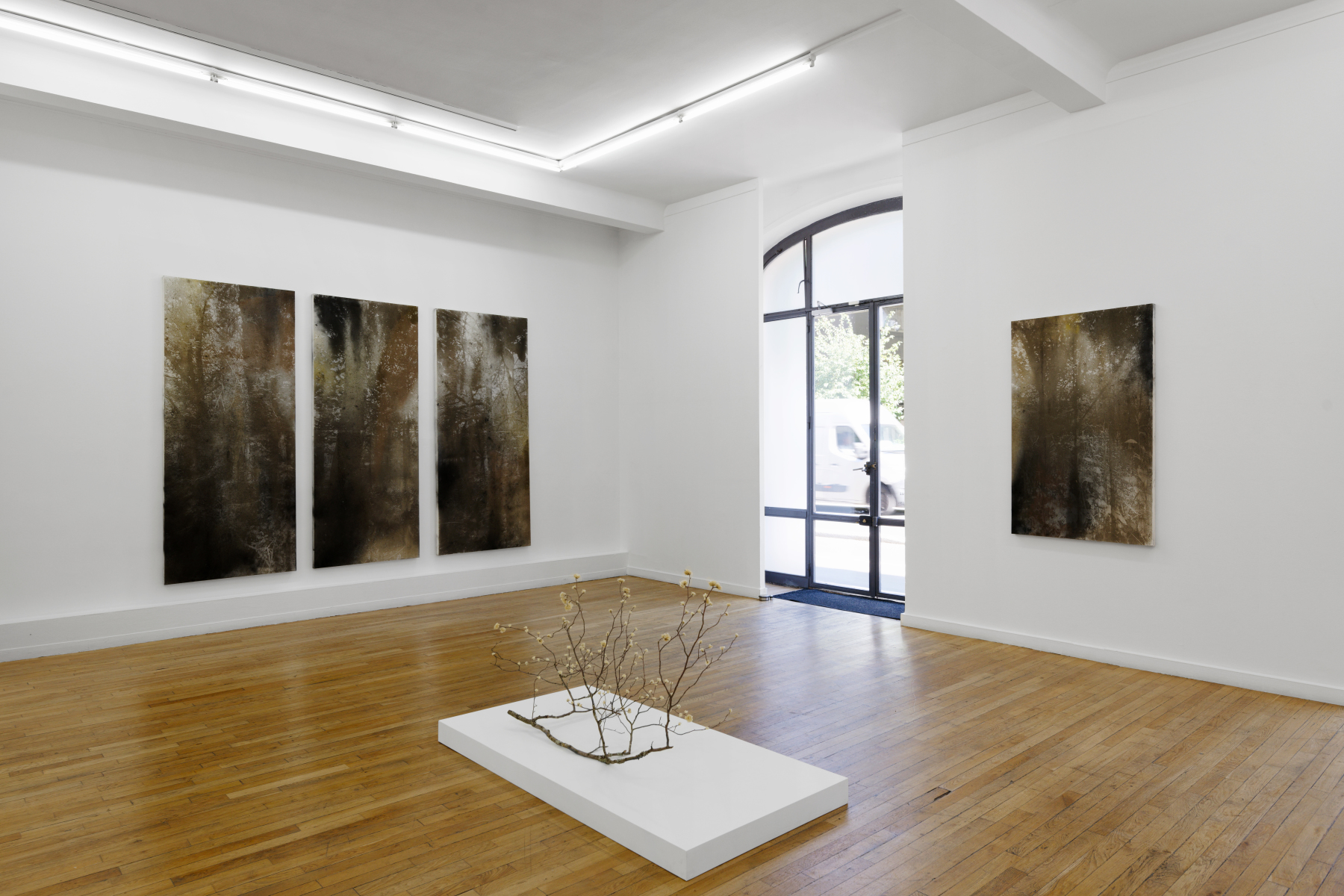Lionel Sabatté
Dust of the heights
September 07 - October 07, 2023
Lionel Sabatté
Dust of the heights
September 07 - October 07, 2023
On the occasion of his new exhibition at Ceysson & Bénétière, Lionel Sabatté will unveil a new series of works resulting from his “poussiérographie technique. The artist recently discovered this process and first applied it on paper before trying it on canvas using screenprinting as a dust collector. This process consists of screenprinting photographs of trees on a white surface with transparent ink. The invisible ghost image captured on the media is revealed only when the artist puts dust on it. Although the process is simple, the artist must be quick since he has to intervene before the ink dries. The ink captures the dust, with its unique texture and shades of grey, and astonishing images appear on the surface of the canvas.
Following a few poussiérographie Sabatté made from photographs of the forest at the Château de Chambord, this new series represents a natural prolongation of the artist’s research, while revealing the uniqueness of this process, which powerful potential the artist has managed to harvest. As he did for several years with his small portraits, Sabatté is now exploring a new way of drawing with dust, this time including a photographic dimension. It was a gradual process for the artist, who initially used photography as drawing, a way of capturing lines, before considering it as a medium in its own right, and integrating photographic elements in some of his works. Always walking on the edge, between reproduction and invention of reality, Sabatté avoids the trap of the graphic and the decorative. Born of the invisible, these ghost images stand on the line between appearance and disappearance.
Sabatté draws from the ambivalent history of photography, between science and alchemy. By doing so, he probably walks in the footsteps of pioneers of photography, like Nicéphore Niepce and his research on the many ways to fix an image on a medium. From photoengraving to heliography, Nicéphore Niepce experimented a lot with the effect of sunlight on all sorts of media coated with various chemical ingredients. Sabatté sees photography as a technique and know-how that allows him to capture a moment of reality, a moment in time. But it is also an alchemical mystery, a somewhat magical technique resulting from a slow development process.
Sabatté likes to play with chance from the very start. When photographing his subjects, he provokes it by playing with backlighting or overexposure for the light to partly burn the image. These accidents often come from blind screenprinting transfer, which blurs the composition in some places, leaving some areas white or creating fictional elements the original photo did not contain: a lake here, a ghost tree there… The work thus takes on a spectral aspect and looks like an old photograph dating from the early time of photography. On a deep level, Sabatté’s relationship to photography has a lot to do with time, a desire to capture a transient moment, to capture a memory in a physical artwork. We could draw parallels with Roman Opalka’s or Christian Boltanski’s use of photography here. Sabatté has a similar attachment to memory. To work with traces, with the residual, the fragile, the precarious, the discarded. To give physical shape to the transient, a moment of eternity.
Sabatté’s photographic images have both temporal and physical density. In his work, image and matter interact on equal terms: what we experience first is the texture of the physical image, something very material that goes beyond a mere surface effect. We see clumps of earthy, grainy, and mineral matter letting the image peak through only partially. Here we can think of the materiality already present in Sabatté’s previous series of paintings exhibited at the Château de Chambord, for which the artist combined painting and dust for the first time. The same thread connects this series of paintings with his poussiérographie, the same anchoring within the expressionist tradition, which, from Dubuffet to Bacon, Rebeyrolle to Leroy, and Velickovic to Kiefer, emphasized the density of the physical image over the illusion of the surface, its materiality over its subject matter.
In this recent series, Sabatté started to use in an original way a big chunk of the dust he had not used before, the most powdery and heavy part of the dust he collected inside the Château de Chambord, the part deposited at the bottom of the vacuum cleaner bags, mixed with dust balls and soil residues from the soles of the visitors who also walked in the surrounding forest. This dust contains traces of lively elements: the castle, people, and nature. Sabatté mixed the dust collected in his Parisian workshop with this harvest. Here, the artist also plays with the idea of reusing remnants of his own past works, bronze carving, and pieces of paintings. It is also a way to play with colors, to highlight or mute the original dust balls.
Sabatté is fascinated by dust from both a symbolic and formal standpoint. It is the dust that makes the motif uneven and partly indiscernible, giving way to a ghost image that is no longer really the forest he photographed but an imaginary forest. “Pollen” and “dust” have a common etymological origin and were the same word during the Renaissance. In the hands of Sabatté, dust turns into pollen and re-pollinates a forgotten forest. This pollen-dust thus symbolizes life, but also death and oblivion. It is a yearning material. It comes from the ground and rises towards the sky. It reveals and plays with light. Sun-dust turned into photon. Dust of the heights. Immortal.
Amélie Adamo, June 2023
Artist : Lionel Sabatté
Visitor Information
Ceysson & Bénétière
23 rue du Renard
75004 Paris
Tuesday - Saturday
11am - 7pm
T: + 33 1 42 77 08 22



